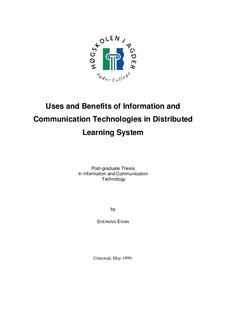| dc.description.abstract | Purpose and Methods. The paper is a presentation of my post graduate thesis at HiA. The focus of this study is Akademiet, a distributed learning system developed by Telenor Kompetanse in Grimstad, Norway. Akademiet is a web application developed for use by Telenor employees and clients who wish to take courses facilitated by the Internet.
The increasing dissemination of networked computers, especially via the Internet, enables and accelerates changes in our educational system. Many reforms sought in education are exemplified and realized through this new distributed learning situation. We have gained some insights into what new conditions distributed learning systems impose on the participants. Examples are users ability to work asynchronously, to communicate via the web, participate in collaborative efforts via multi media applications, simulate complex problems by use of computers and networks and the increased flexibility in deciding what, where and when to study. Other aspects of our knowledge are limited. One of the key aims of this effort is to develop an understanding of possibilities and constraints of distributed learning systems in the following domains:
• Educational changes with respect to distributed learning situations, especially with regard to technical, organizational and pedagogical issues.
• How these changes mediate and effect social interactions and knowledge construction in a complex manner.
It is difficult to design good learning environments for use in distributed learning systems. Most current design and course development in this area proceeds primarily on technical premises, with other relevant aspects, such as pedagogical approach and social situation, given only secondary consideration. The main goal of my study is to improve the quality and to increase the efficiency of learning in distributed learning systems, with the focus on Akademiet. My basic argument is that a broader view of design, development, and deployment which takes into account organizational and pedagogical issues as well as technical conditions, with attention to context, is more likely to produce improved learning.
In order to make recommendations for improving Akademiet, including how courses should be designed, which applications are appropriate, and how they should be implemented, it is important to have solid background material to support my views. This background consists of both a sound theoretical perspective derived from a review of educational research literature, and empirical data collected specifically with regard to Akademiet.
Primary data was gathered by investigating Akademiet and its surroundings. Secondary data was collected by examining other distributed learning systems, both domestic and foreign, by reviewing other research findings, and by general information gathered through the Internet and literature. Questionnaires were developed and distributed to students at HiA and employees of Telenor; not all of those answering questionnaires had experience with Internet courses. The employees in Telenor who were surveyed did have access to and experience with Akademiet, so results from that research are directly related to Akademiet, whereas other survey data provided a general framework for background considerations. I had several conversations with highly qualified researchers in this area. Various persons in the research staff at Telenor Kompetanse and at Telenor FoU gave me relevant feedback and information for use in this study. I believe that the results from Akademiet, my own research, and these discussions provide a solid background to support my findings and recommendations.
Summary of Findings and Recommendations
Course development is too often driven by technical constraints and considerations, with pedagogical and organization considerations getting only secondary treatment. The result of inadequate attention to organizational, social and pedagogical issues in the design and development of distributed learning systems is reduced learning effectiveness and marginal benefits to individuals and organizations. Fortunately, this situation can be improved using the available technologies involved in the learning environments.
To understand educational changes associated with distributed learning situations, we need to take into account the entire learning situation, including technical aspects as well as organizational and pedagogical aspects, with particular attention to the way that all of these mediate and effect social interaction and knowledge construction. Activity theory, distributed cognition, and other related theoretical perspectives suggest fundamentally new ways to design and form distributed learning environments.
The results which are presented in this task are examples of conditions, and not necessarily generally features in educational establishments and organizations. Through the research these conclusions are made:
• Through use of ICT the teaching gets more individualized and fluctuating.
• Use of visualization increases.
• The focus is on student roles. New opportunities to make connections between the students and their interests are possible.
• Motivation can increase among students with a positive attitude, where age, education and living situation influences the motivation by the technology. There is not any indication that the gender influences the motivation.
• Positive sides with classroom education can be described with; good social settings, and the negative sides with; bad individual needs. In distributed learning environments the respective headwords are; personal needs / adjustments, and; isolation.
New technologies introduce new problems with regard to planning and implementing support for learning. As has been historically the case, it is not the new media that dictate how and what can be efficiently learned. Rather, it has been the understanding of the possibilities introduced by new media and then the effective integration of those possibilities into sound pedagogical frameworks, which has proven effective in improving learning. All too often, we have failed to effectively integrate new technologies into learning, and much of this failure is a result of continuing to do what was appropriate for older methods and settings. | en |
